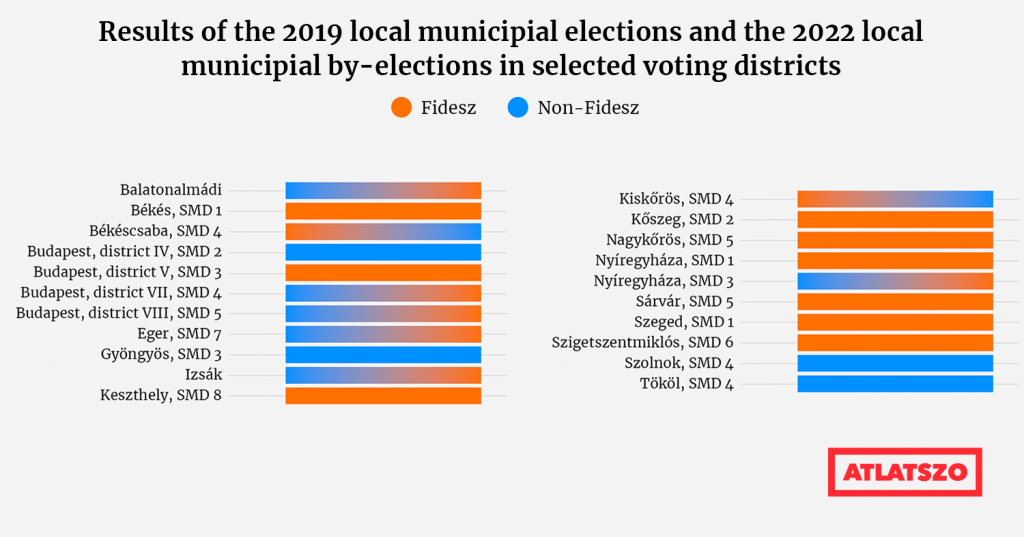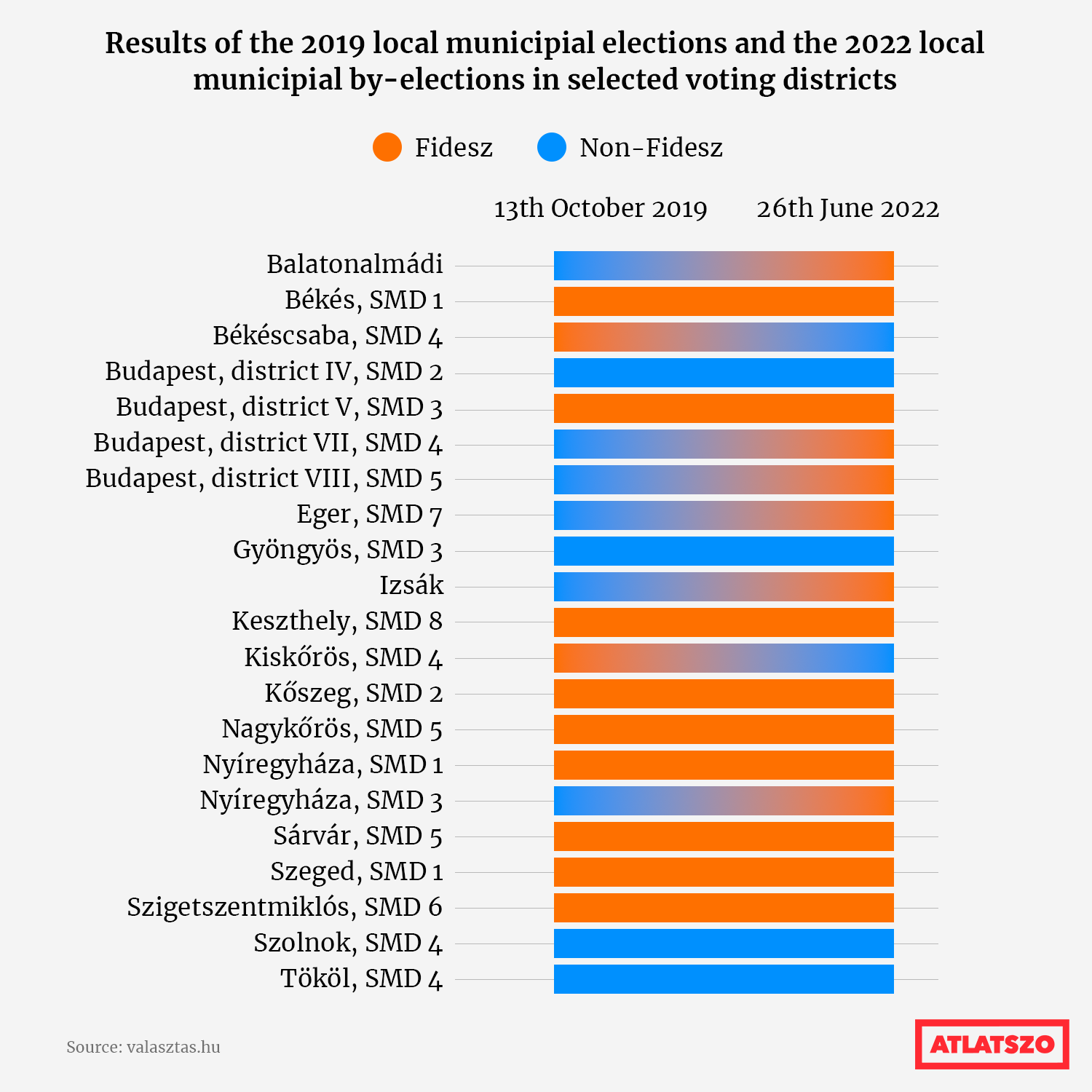The https://english.atlatszo.hu use cookies to track and profile customers such as action tags and pixel tracking on our website to assist our marketing. On our website we use technical, analytical, marketing and preference cookies. These are necessary for our site to work properly and to give us inforamation about how our site is used. See Cookies Policy
Run(a)way – oppositional bust at municipal by-elections explained in infographics
On 26th June 2022, more than 70 local municipal by-elections were held across Hungary. In this article, we’ll take a look at 21 of these elections. From the results, it seems that the successes of Fidesz and the ordeals of the opposition must go on.
On 26th June 2022, an unusually high number of municipal by-elections were held across Hungary. Since COVID related and other restrictions halted by-elections, municipalities could only re-start arranging these events in May made necessary by resignations, dismissals or passings of local politicians. Thus, the Sunday election day brought more than seventy local by-elections, more than twenty of which being held in city rank districts. In the context of national politics, one might find some notion of importance in the latter of these elections.

The question, though, is whether there is any importance to begin with. On their own, these local elections do not tell much about the general feeling of people. Since 3rd April 2022 (the day of the Hungarian parliamentary elections), this was the first occasion that might give us a detailed look on the state of national politics apart from polls.
There were so many elections in such diverse locations that it is worth taking a closer look at the results. Neither the regional differences nor the special attributes of the type of constituency distorts the outcome this time, as there were elections held from the East-Hungarian Nyíregyháza (a big city), to the West-Hungarian Kőszeg (a small city), to the capital city Budapest and settlements from its agglomeration (Szigetszentmiklós, Tököl), county seats like Szeged, Szolnok or Békéscsaba, small settlements like Gyöngyös or Sárvár, and even some villages.
Hungarian parliamentary election 2022 – Maps and charts about the final results
The Hungarian parliamentary elections were held last Sunday, on 3 April. Átlátszó has been following the whole process from the…
In our collection, we took a closer look on those 21 locations, where elections were held in a single-member district system. In other words, we included locations that are regarded as big settlements according to the election process.
Nevertheless, the results of two smaller settlements (Balatonalmádi, Izsák) are also included in our collection. We did not include, however the election held at Keszthely, as the MP of the Keszthely district Jenő Manninger ran without any opponents. The by-elections were necessary as Manninger stepped down from his parliamentary seat, taken over by Bálint Nagy in the April parliamentary elections. Nagy was, however, the mayor of Keszthely previously, so technically the two politicians switched places, without any oppositional friction.
We must also take into consideration that at these locations, voters only voted for individual runners, not party lists, which slightly alters party sympathy voting. We tried not to compare apples to oranges, so for the April 2022 voting, we also only included the results of individual runners. Finally, we must highlight that for a number of locations, there were no party-backed runners but members of local organisations, who were, nevertheless, backed by parties of either side. Considering all these exeptions, the results were as follows.
It is clear that these elections were mostly held on oppositional grounds. For simplicity’s sake, the “Non-Fidesz” group (including all other runners) gained more votes than the Fidesz-backed runner in 2019 at almost all locations. This changed for April 2022, as from the twenty-one locations, nine were won by Fidesz-politicians, and for June 2022, thirteen were won by Fidesz-backed runners.
Since the population of these locations vary a lot, we summarised the votes into two big categories (“Fidesz”, “Non-Fidesz”), to see the overall voting mood of each elections. Here we can see a landslide victory for the “Non-Fidesz” group in 2019, (let’s not forget that these are only mostly city rank settlements!), a more or less equal result in April 2022 and an overall win for Fidesz in June 2022.
This, of course is not only influenced by party-orientation but by voter turnout, as well. in 2019, these 21 locations had a total of twenty thousand “Non-Fidesz” voters, which increased to twenty-six thousand five hundred in April 2022, just to be followed by a drop to seven thousand in June 2022.
The actual numbers are even less, since at Gyöngyös, Szolnok or Tököl, Fidesz appointed an independent runner both in 2019 and April 2022, but in June 2022, the member of a local organisation received the Fidesz-votes, of which we included in the “Non-Fidesz” group (since they were not technically Fidesz-runners).
The next chart illustrates whether the winner of the 2019 municipal elections was a member of Fidesz or not and how these power relations shifted by June 2022.
We can then say that the opposition really held ground at Gyöngyös and at the fourth district of Budapest, and at Újpest, they received severe losses. At Tököl, an independent runner won, while at Szolnok, a government-backed member of a local organisation got the most votes, so Fidesz won this district indirectly.
The same can be said about the seventh and eight districts of Budapest, Eger, Nyíregyháza, Balatonalmádi and Izsák. Nothing of such happened the other way around: at Kiskőrös, an independent runner won over the Fidesz-runner, while at Békéscsaba, a politically unidentifiable mayor (who was reviously backed by Fidesz) won the election. This counts as much as an oppositional win as there were no oppositional runners here in order to defeat Fidesz. Finally, Fidesz held ground at nine locations, mostly with over eighty percent of the votes.
We cannot say much about the oppositional parties. At some locations, Momentum tried to run (at Kőszeg and Tököl), with no success. At Nyíregyháza, instead under the name of the “official” oppositional coalition, a member of the opposition party Párbeszéd, and a member of MMM (Mindenki Magyarországa Mozgalom [Hungary is for Everybody], the party of then oppositional PM-candidate Péter Márki-Zay) ran and lost against the Fidesz-runner. Parties not part of the oppositional coalition, such as Mi Hazánk (Our Homeland Movement) (Békés: 31%, Kőszeg: 12%) and MKKP (Magyar Kétfarkú Kutya Párt [Two Tailed Dog Party]) (Erzsébetváros: 13%) had good results, but at other locations where they ran (MKKP:Szeged, Újpest: 2-4%, Mi Hazánk: Eger, Szigetszentmiklós, Újpest: 1.5-6%), there was no significant breakthrough.
We must mention that by-elections must be handled as nothing else than by-elections: these are held with significantly lower voter turnout. One evident reason for this is that at summertime, the voting mood is always lower. The other reason can be tied to the April elections and the political depression that resulted from it. From the turnout data we nevertheless see some impressive outliers and differences.
So these are the facts. Let’s have some more subjective comments about these elections. In a previous political analysis, we wrote that the opposition had celebrated a loss as a victory in 2019. Even though they had won numerous municipal districts, Fidesz still won the election and could increase their voter base since the previous municipal elections held in 2014. The results of June 2022 will probably have a sobering effect, though.
One can of course minimise the results of June 2022 saying that the voter turnout was relatively low. We would respond saying that in Józsefváros, the eight district of Budapest, there was a previous by-election held four years ago in a similarly depressed political atmosphere, that had resulted a similar two-third majority Fidesz-win. The only difference is that Fidesz was in office, and the so-called incumbent effect helped the governmental candidate, which is usually a pivotal aspect at municipal elections, even more so at by-elections.
This time, the national opposition rules the local opposition power. This, however, debunks even more oppositional myths. In 2019, the most important message of the opposition was that municipal power means important resources that can back oppositional expanse. We did not see such to happen, on the contrary, it uncovered another myth about the opposition.
If we look at the aforementioned turnout data, we can conclude, that turnout was high in places where a local issue overruled party importance. At Kiskőrös, an independent candidate encouraged locals to vote because of a local issue, and electing a mayor is not a party issue in a small city either (like at Balatonalmádi or Izsák).
Of all mentioned above, we can conclude the following: in 2019, the overly oppositional municipalities could win over Fidesz. These oppositional winners then promised a new, reformed, oppositional management model, that can serve as an example in the future – nothing of this kind was visible in June 2022. Municipal positions are useful for their incumbents if they do not focus on but distances themselves from party issues. This, however, can easily draw them towards governmental influence. They can also try to outline their work as a political experiment against Fidesz – that way, however, their loss is inevitable.
Translated by Krisztián Szabó. The original, Hungarian version of this article was written by András Hont and Krisztián Szabó and can be found here.



